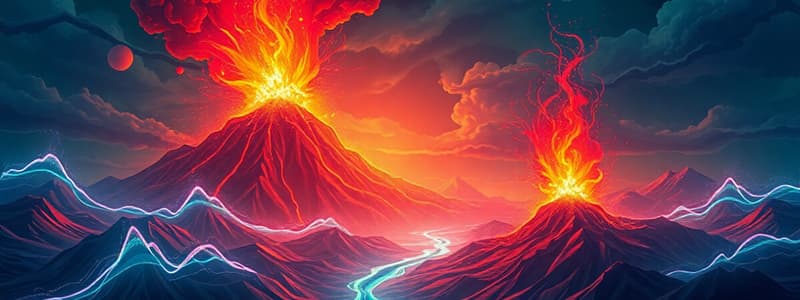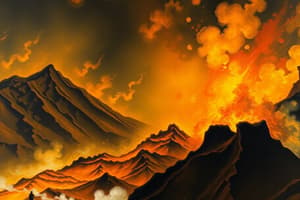Podcast
Questions and Answers
Which statement accurately describes the relationship between the focus and epicenter of an earthquake?
Which statement accurately describes the relationship between the focus and epicenter of an earthquake?
- The focus is a point on Earth's surface, while the epicenter is located deep within Earth.
- The epicenter is the point inside Earth where the earthquake originates, whereas the focus is on the surface directly above it.
- The focus and epicenter are the same location, representing the area of greatest damage on Earth's surface.
- The focus is the point inside Earth where the earthquake originates, and the epicenter is the point on Earth's surface directly above the focus. (correct)
A seismograph station records a significant time lag between the arrival of P-waves and S-waves. What does this indicate about the earthquake's epicenter?
A seismograph station records a significant time lag between the arrival of P-waves and S-waves. What does this indicate about the earthquake's epicenter?
- The epicenter is very close to the seismograph station.
- The epicenter is located on the opposite side of the Earth.
- The epicenter is at an intermediate distance from the seismograph station. (correct)
- The time lag is unrelated to the epicenter's distance.
Why are S-waves crucial in determining the liquid state of Earth's outer core?
Why are S-waves crucial in determining the liquid state of Earth's outer core?
- S-waves cannot travel through liquids, creating a 'shadow zone'. (correct)
- S-waves are stronger than P-waves and can penetrate further.
- S-waves speed up significantly when passing through liquid.
- S-waves are completely absorbed by solids.
Which type of seismic wave typically causes the most significant damage to buildings and infrastructure during an earthquake?
Which type of seismic wave typically causes the most significant damage to buildings and infrastructure during an earthquake?
At which type of plate boundary would you most likely find a reverse fault?
At which type of plate boundary would you most likely find a reverse fault?
What information is needed from at least three seismograph stations to accurately pinpoint the epicenter of an earthquake using triangulation?
What information is needed from at least three seismograph stations to accurately pinpoint the epicenter of an earthquake using triangulation?
If an earthquake occurs, and a nearby city is located on a fault line, which type of fault would cause rocks to move past each other horizontally?
If an earthquake occurs, and a nearby city is located on a fault line, which type of fault would cause rocks to move past each other horizontally?
Which scale is most accurate for measuring the total energy released by a major earthquake?
Which scale is most accurate for measuring the total energy released by a major earthquake?
The Modified Mercalli Scale is used to measure what aspect of an earthquake?
The Modified Mercalli Scale is used to measure what aspect of an earthquake?
Which of the following factors is NOT typically used by seismologists to assess earthquake risk in a region?
Which of the following factors is NOT typically used by seismologists to assess earthquake risk in a region?
Which geological setting is LEAST likely to be associated with the formation of volcanoes?
Which geological setting is LEAST likely to be associated with the formation of volcanoes?
What type of volcano is characterized by its large size, gentle slopes, and relatively gentle eruptions?
What type of volcano is characterized by its large size, gentle slopes, and relatively gentle eruptions?
Which characteristic of lava would MOST likely lead to a violent volcanic eruption?
Which characteristic of lava would MOST likely lead to a violent volcanic eruption?
What is a caldera?
What is a caldera?
Which of the following volcanic eruption effects is LEAST likely to be deadly?
Which of the following volcanic eruption effects is LEAST likely to be deadly?
Which of the following is a reliable indicator of a potential volcanic eruption?
Which of the following is a reliable indicator of a potential volcanic eruption?
Flashcards
Earthquake
Earthquake
Vibrations in the Earth’s ground caused by movement of plates at fault lines.
Fault
Fault
A break in Earth’s lithosphere where rock masses move relative to each other.
Strike-Slip Fault
Strike-Slip Fault
Occurs at transform plate boundaries.
Normal Fault
Normal Fault
Signup and view all the flashcards
Reverse Fault
Reverse Fault
Signup and view all the flashcards
Seismic Waves
Seismic Waves
Signup and view all the flashcards
Focus
Focus
Signup and view all the flashcards
Epicenter
Epicenter
Signup and view all the flashcards
Modified Mercalli Scale
Modified Mercalli Scale
Signup and view all the flashcards
Earthquake Risk Indicators
Earthquake Risk Indicators
Signup and view all the flashcards
Volcano
Volcano
Signup and view all the flashcards
Volcano Formation
Volcano Formation
Signup and view all the flashcards
Shield Volcano
Shield Volcano
Signup and view all the flashcards
Composite Volcano
Composite Volcano
Signup and view all the flashcards
Caldera
Caldera
Signup and view all the flashcards
Predicting Volcanoes
Predicting Volcanoes
Signup and view all the flashcards
Study Notes
- Study notes on earthquakes and volcanoes by Maja Kusmierz
Earthquakes
- Earthquakes are vibrations in the ground due to the movement of plates at fault lines
- Most earthquakes occur along plate boundaries
Faults
- Faults are breaks in Earth's lithosphere where one block of rock moves relative to another.
- Strike-slip faults occur at transform plate boundaries.
- Normal faults occur at divergent plate boundaries.
- Reverse faults occur at convergent plate boundaries.
Earthquake Focus and Epicenter
- Seismic waves are energy that travels as vibrations in Earth.
- The focus is the point inside Earth where an earthquake begins.
- The epicenter is the location on Earth's surface directly above the focus.
Types of Seismic Waves
- Primary waves travel in a push-pull motion and are the fastest seismic waves, they can travel through solids and liquids
- Secondary waves are slower than P-waves, travel through solids only involving an up and down motion
- Surface waves move in a rolling motion, are the slowest, and cause the most damage to Earth's surface.
Earth's Interior
- Scientists discovered that Earth's outer core is liquid because S-waves cannot travel through liquids, while P-waves can travel through both solids and liquids.
Finding the Epicenter
- Finding the epicenter involves triangulation
- First find the difference in arrival time between the p-wave and s-wave (lag time)
- Determine the distance from the epicenter using an earthquake distance graph
- Draw a circle with the correct distance around the station, then repeat for two stations
- The intersection of the circles marks the location of the epicenter
Measuring Earthquakes
- Richter Scale measures the amount of ground motion at a given distance
- Moment Magnitude Scale measures the total amount of energy released by an earthquake
- Modified Mercalli Scale measures earthquake intensity based on observed damage and uses a scale of I-XII
Earthquake Risks
- Seismologists use a list of indicators to assess earthquake risk:
- Past earthquakes
- Probability
- Population density
- Geology around a fault
- Building design
Volcanoes
- Volcanoes are vents in Earth's crust through which molten rock flows
- Volcanoes form where two plates collide and one plate subducts under another
- Divergent boundaries where two plates separate and magma comes out
- Volcanoes also form at hot spots, which are not associated with plate boundaries and often form chains of islands like Hawaii
Types of Volcanoes
- Shield Volcano: Large shield-shaped volcanoes with gentle slopes and gentle eruptions.
- Composite Volcano: Large, steep-sided volcanoes that result from explosive eruptions.
- Cinder Cone Volcano: Small, steep-sided volcanoes that erupt gas-rich, basaltic lavas with moderately explosive eruptions.
Caldera
- Caldera: Large volcanic depression created when the summit of the volcano collapses during a violent eruption
Types of Eruptions
- Violent Eruptions: associated with lava that has a high viscosity (thick lava) and high gas content.
- Quiet Eruptions: associated with lava that has a low viscosity (thin lava) and low gas content.
Effects of Volcanic Eruptions
- Lava Flows move slowly, can destroy towns, but are rarely deadly
- Ash Fall causes breathing problems, can cool Earth's atmosphere, and disrupt air traffic
- Mudflows can cause snow and ice to melt which mixes with mud/ash
- Pyroclastic Flow can be deadly, produced from violent eruptions, and throw gas, ash and rock into the air
Predicting Volcanoes
- Signs include ground deformation, increased earthquake activity, increased volcanic gas emissions, and water near the volcano becoming more acidic
Climate
- Volcanic eruptions can affect the climate.
- Volcanic ash can block sunlight and cause a decrease in global temperatures.
- Volcanic eruptions can also cause rain.
Studying That Suits You
Use AI to generate personalized quizzes and flashcards to suit your learning preferences.




